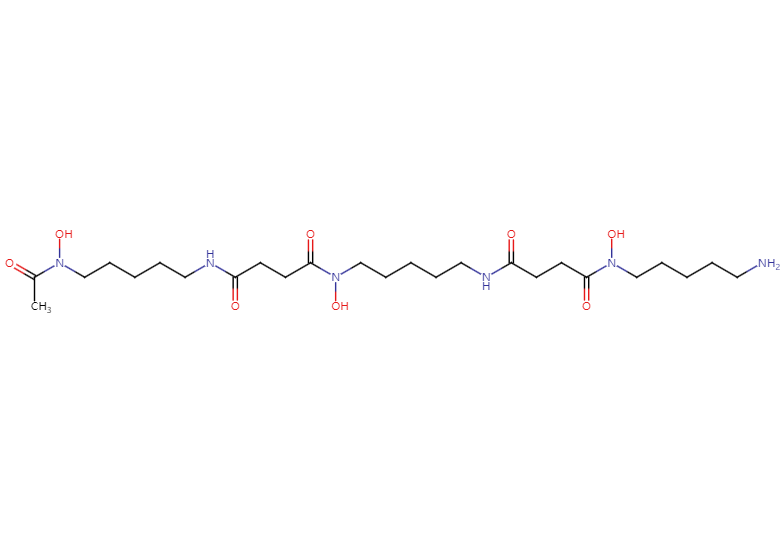store at low temperature
Powder: -20°C for 3 years | In solvent: -80°C for 1 year
Deferoxamine(Desferrioxamine B) is an iron chelator (binds Fe(III) and many other metal cations) that inhibits neuronopathy, may be used to modify the reduction of iron accumulation and deposition in tissues, and may improve neurological dysfunction by inhibiting iron death and neuroinflammation following traumatic brain injury.Desferrioxamin-B has antioxidant, antiproliferative, Deferoxamine has antioxidant, antiproliferative, and antitumor activities, and can induce HIF-1α production, apoptosis and autophagy in cancer cells.Desferrioxamin-B can be used in the treatment of acute iron toxicity and COVID-19 related diseases.

| パッケージサイズ | 在庫状況 | 単価(税別) | |||
|---|---|---|---|---|---|
| サンプルについてお問い合わせ | |||||
| 1 mg | 在庫あり | ¥ 15,000 | |||
| 5 mg | 在庫あり | ¥ 39,500 | |||
| 10 mg | 在庫あり | ¥ 62,000 | |||
| 25 mg | 在庫あり | ¥ 105,000 | |||
| 50 mg | 在庫あり | お問い合わせ | |||
| 説明 | Deferoxamine(Desferrioxamine B) is an iron chelator (binds Fe(III) and many other metal cations) that inhibits neuronopathy, may be used to modify the reduction of iron accumulation and deposition in tissues, and may improve neurological dysfunction by inhibiting iron death and neuroinflammation following traumatic brain injury.Desferrioxamin-B has antioxidant, antiproliferative, Deferoxamine has antioxidant, antiproliferative, and antitumor activities, and can induce HIF-1α production, apoptosis and autophagy in cancer cells.Desferrioxamin-B can be used in the treatment of acute iron toxicity and COVID-19 related diseases. |
| In vitro |
Deferoxamine (1 mM; 16 hours or 4 weeks) improves HIF-1α function under hypoxic and hyperglycemic conditions and reduces ROS in MEF cells.[1] Deferoxamine mesylate (100 μM; 24 h) increases InsR expression and activity and induces increased p-Akt/total Akt/PKB levels.[2] Deferoxamine (5, 10, 25, 50, 100 μM; 7 or 9 days) inhibits the proliferation of tumor-associated MSCs and bone marrow MSCs.[3]. Deferoxamine (5, 10, 25, 50, 100 μM; 7 days) induces apoptosis in mesenchymal stem cells.[3] Deferoxamine (10 μM; 3 days) affects the expression of mesenchymal stem cell adhesion proteins[3] Deferoxamine (100 μM; 24 h) induces autophagy-mediated by HIF-1α levels in SH-SY5Y cells.[4] |
| In vivo |
Deferoxamine (6.57 μg/mouse; drip; once daily for 21 days) promotes wound healing and increases neovascularization in aged or diabetic mice.[1] Deferoxamine (200 mg/kg; i.p.; once daily for 2 weeks) causes HIF-1α stabilization and increases glucose uptake, hepatic InsR expression, and signaling in vivo.[2] |
| 別名 | Deferoxamine B, Desferrioxamine B |
| 分子量 | 560.68 |
| 分子式 | C25H48N6O8 |
| CAS No. | 70-51-9 |
store at low temperature
Powder: -20°C for 3 years | In solvent: -80°C for 1 year
DMSO: 10 mg/mL (17.84 mM), Sonication is recommended.
H2O: 7.14mg/ml(12.74mM)
You can also refer to dose conversion for different animals. 詳細
bottom
Please see Inhibitor Handling Instructions for more frequently ask questions. Topics include: how to prepare stock solutions, how to store products, and cautions on cell-based assays & animal experiments, etc.
Deferoxamine 70-51-9 Angiogenesis Apoptosis Autophagy Chromatin/Epigenetic oxidation-reduction Antioxidant HIF Deferoxamine B Desferrioxamine B Inhibitor inhibitor inhibit
